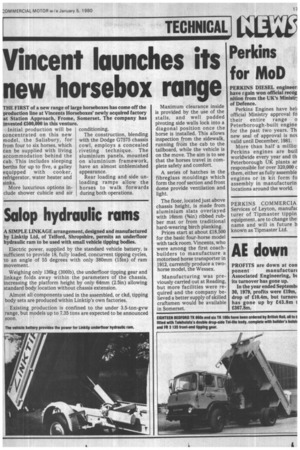Vincent launches its new horsebox rctn e
Page 19

If you've noticed an error in this article please click here to report it so we can fix it.
THE FIRST of a new range of large horseboxes has come off the production line at Vincents Horseboxes' newly acquired factory at Station Approach, Frome, Somerset. The company has invested £500,000 in this venture.
Initial production will be concentrated on this new model, the Salisbury, for from four to six horses, which can be supplied with living accommodation behind the cab. This includes sleeping berths for up to five, a galley equipped with cooker, refrigerator, water heater and sinks.
More luxurious options include shower cubicle and air conditioning.
The construction, blending with the Dodge G7575 chassis cowl, employs a concealed riveting technique. The aluminium panels, mounted on aluminium framework, have an almost unblemished appearance.
Rear loading and side unloading ramps allow the horses to walk forwards during both operations. Maximum clearance inside is provided by the use of the stalls, and well padded pivoting side walls lock into a diagonal position once the horse is installed. This allows inspection from the sidewalk, running from the cab to the tailboard, while the vehicle is on the move. The aim is to see that the horses travel in complete safety and comfort.
A series of hatches in the fibreglass mouldings which form the roof section and front dome provide ventilation and light.
The floor, located just above chassis height, is made from aluminium slats overlayed with 16mm (Fain) ribbed rubber mat or from traditional hard-wearing birch planking.
Prices start at about £18,500 for the basic four-horse model with tack room. Vin cents, who were among the first coachbuilders to manufacture a motorised horse transporter in 1912, currently produce a twohorse model, the Wessex.
Manufacturing was previously carried out at Reading, but more facilities were required and the company believed a better supply of skilled craftsmen would be available in Somerset.
















































































